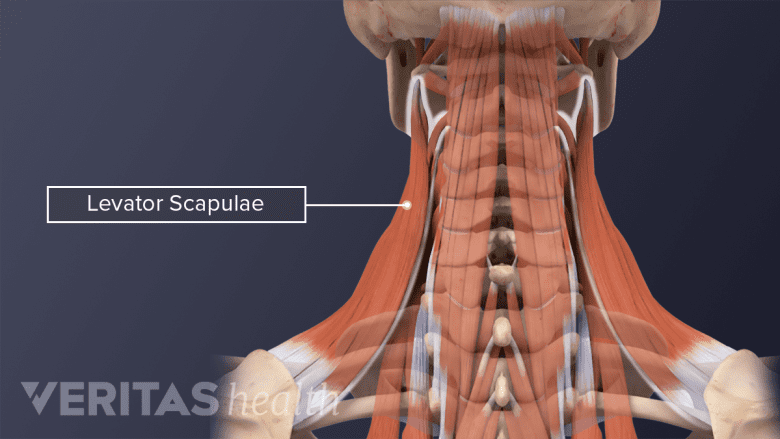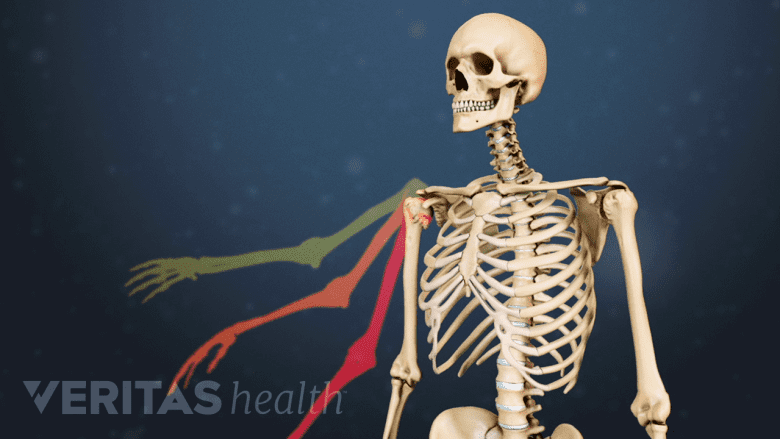When neck pain and shoulder pain occur together, some people may find the neck pain more concerning. For others, the shoulder pain may be more painful or limit more activities. Depending on the cause of the pain, it is also possible for the neck and shoulder pain to alternate in intensity during different activities.
In This Article:
- Understanding Neck and Shoulder Pain
- What Causes Neck and Shoulder Pain?
- Causes of Shoulder Blade Pain Video
Common Causes of Neck and Shoulder Pain
Some of the more common causes of neck and shoulder pain include:
Cervical herniated disc
When a cervical disc’s tough outer layer (annulus fibrosus) tears or partially tears and the soft inner layer (nucleus pulposus) starts to leak outward, the nearby nerve root can become inflamed and painful. If a disc in the lower cervical spine herniates, radicular pain in the shoulder blade region may accompany the neck pain.
Watch Cervical Herniated Disc Video
Cervical spondylosis
Degeneration in the cervical spine, also called cervical spondylosis, can involve cervical osteoarthritis, cervical degenerative disc disease, and other wear-and-tear conditions of the spine. As the spine eventually starts to degenerate with age, one or more intervertebral foramen (bony openings where the spinal nerves exit the spinal canal) may become smaller, called foraminal stenosis. With less room, a spinal nerve may become compressed or inflamed, causing pain to radiate from the neck down into the shoulder.
Muscle strain

Strain in the muscles that connect the neck and shoulder causes pain in both regions.
Several muscles are connected to both the neck and shoulder, such as the levator scapulae and trapezius. When one of these muscles becomes strained, pain and stiffness may be felt in both the neck and shoulder. Even in cases where a muscle strain develops in only the neck or shoulder, the pain may be referred to a nearby body region.
See Neck Strain: Causes and Remedies
Stinger injury
When a collision causes the neck to bend sideways, it may overstretch the nerves between the neck and shoulder, causing a stinger injury. A stinger injury, also called a burner, typically results in a shock-like pain that shoots down the arm and may also include some tingling, weakness, or numbness. Stingers usually go away quickly, but they may last longer. A sports collision, such as during football or hockey, is a common cause of stinger injury.
Read more about Stinger Injuries on Sports-health.com
Sometimes neck and shoulder pain may have more than one cause. For example, a traumatic injury, such as a car collision or falling from a ladder, may cause a herniated disc, fracture, and muscle strain that all contribute to the neck and shoulder pain.
Other Causes of Neck and Shoulder Pain
Some less common causes of neck and shoulder pain may include:
Thoracic outlet syndrome

Compression of nerves and/or blood vessels within the thoracic outlet causes neck and arm pain.
This condition occurs when nerves and/or blood vessels become compressed within the thoracic outlet (the small area between the top rib and collarbone). Thoracic outlet syndrome most commonly causes pain, tingling, numbness, or weakness in the shoulder and/or arm. It may also be accompanied by neck pain. When thoracic outlet syndrome is caused by compressed blood vessels, the neck pain may feel hot or cold due to poor circulation. When nerves are compressed, the tingling or numbness may be felt in the neck.
Brachial neuritis

Inflammation of the brachial plexus nerves causes brachial neuritis.
When inflammation or damage occurs in the brachial plexus—a group of nerves that travel through the shoulder from the lower neck and upper back—it is called brachial neuritis. This condition typically starts suddenly, such as with sharp or electric shock-like pain. While brachial neuritis pain is usually felt on one side of the body in the shoulder or arm, it may also be felt in the neck. Tingling, numbness, and/or weakness may also go into the shoulder, arm, or hand.
See Brachial Neuritis Symptoms
Cervical myofascial pain syndrome
This condition of unknown cause includes painful trigger points in the neck’s muscles and fascia (connective tissues). When a trigger point in the neck is pressed, it may refer pain down into the shoulder or other nearby areas.
See Treating Neck Pain from Myofascial Pain Syndrome
Shoulder osteoarthritis

Pain and weakness from shoulder osteoarthritis can cause limited arm movement.
The breakdown of protective cartilage within the shoulder joint can lead to pain and inflammation. Degenerative changes within the shoulder joint may also cause nerve compression that radiates pain up to the neck.1Arthritis of the Shoulder. American Academy of Orthopaedic Surgeons website. http://orthoinfo.aaos.org/topic.cfm?topic=a00222. Last reviewed: January 2013. Accessed August 8, 2019.
Read more about Shoulder Osteoarthritis on Arthritis-health.com
Fibromyalgia
This syndrome typically involves widespread pain, fatigue, tender points, and commonly coexists with mental health issues such as depression or anxiety. The myofascial pain is often associated with trigger points that may be present in various parts of the body, especially in the neck and shoulders. Trigger points may feel tender or tight, and they can refer pain to nearby areas when pressed.
Many other causes of neck and shoulder pain exist. Visit a doctor for any neck or shoulder pain that persists for more than a week or two. If pain is accompanied by any troublesome signs or symptoms, such as weakness, numbness, dizziness, nausea, or problems with coordination, seek immediate medical attention.
See 2 Neck Pain Symptoms That Require Immediate Medical Attention
- 1 Arthritis of the Shoulder. American Academy of Orthopaedic Surgeons website. http://orthoinfo.aaos.org/topic.cfm?topic=a00222. Last reviewed: January 2013. Accessed August 8, 2019.

